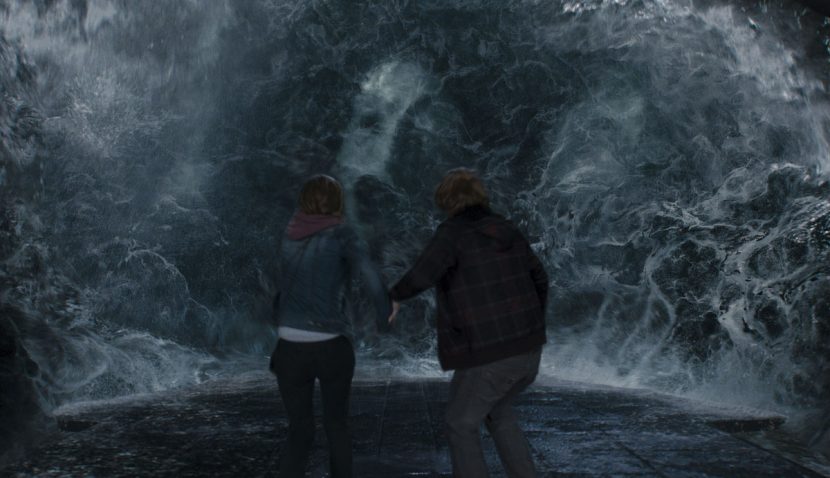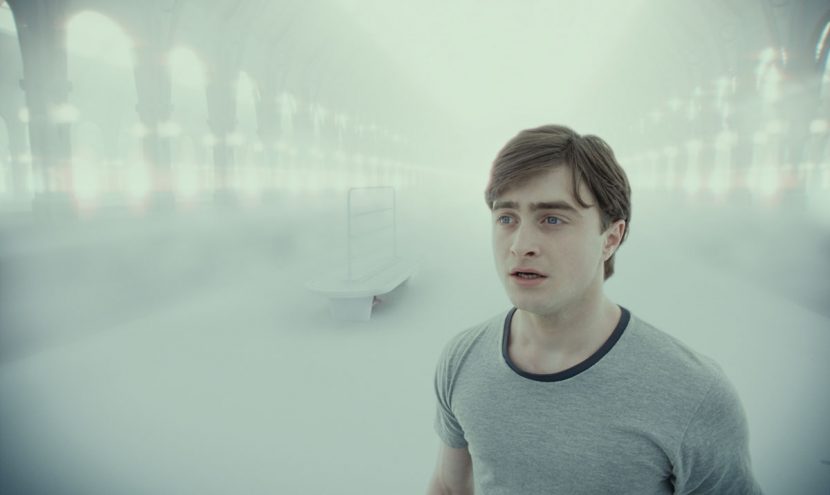Under visual effects supervisor Andy Kind, Framestore completed the Chamber of Secrets water sims, the heavenly Kings Cross sequence and the final ’19 years later’ shots for Harry Potter and the Deathly Hallows: Part 2. We talk to senior FX TD Alex Rothwell and lead compositor Christian Kaestner about the work.
fxg: For the Chamber of Secrets scene, which is where Ron and Hermione destroy the cup horcrux causing the water to rise up, how was that environment filmed?
Rothwell: They had a partial set with the central causeway and then green screen, and everything else was created as a set extension and simulated water, which we rendered in stereo. The challenge there was to create water, of course, but to have it influenced by some sort of magical force.
fxg: How did you approach the water sims?
Rothwell: We used Naiad from Exotic Matter. We started by producing low-res simulations that we were controlling with a variety of forces and animated geometry. Then we’d put those low-res sims in front of Tim Burke, who gave us feedback on what he thought the water should be doing, its size and screen coverage and how much energy it has. After he signed off on that sim, we started working that up in higher-res, trying to keep the movement the same.
One of the big challenges of the piece was that it wasn’t lots of fountains of water that were all sim’d separately and then could be placed on the screen – it was one monolithic simulation where you could see the water from right underneath the camera extending away and rising up to form the central column of twisting water.
fxg: How does Naiad translate into the rendering process and Framestore’s own pipeline?
Rothwell: The outputs from Naiad let you render a voxel-based volume or a set of particles representing where the fluid lies. We were taking the particles – huge numbers of particles – and putting them into a system developed by our R&D department called fApproxDist, a plugin which produced a high resolution mesh. We pumped that through RenderMan via a shader we developed for this show, which took care of all the internal scatter and the nice highlights and caustics.
Then there were other components we layered on top of that, such as spray and foam floating on the water’s surface. They come out as particle files, but are actually rendered as blobby particles on top of the pre-meshed water surface. They’re shaded in a different way, and it’s often the spray and foam that gives the kind of crisp detail that helps give a sense of scale. We also did some dressing sims, and sometimes layered in some 2D elements.

fxg: There’s a face shape inside the water as well – how was that achieved?
Rothwell: That was initially going to play a bigger part in the sequence, but as it progressed we scaled down the use of faces in the water. The system we produced involved placing near the mesh a series of contorted heads and then we used the sim, and then advected them forwards and backwards from that key moment. That allowed the faces to flow in and flow out in a fluid-like motion.
fxg: Can you talk about some of the compositing challenges of that water sequence?
Kaestner: From a compositing point of view, it was a bit of a challenge because with water renders you don’t always get the full set of passes. We spent a lot of time with the 3D guys to work on the water shaders to get all the sub-surface scattering and scale right for the water. The other challenging aspect was the stereo part of the renders. We quickly realized that when we first did our stereo renders for the water, if you do them mathematically correct you get a difference in the left and right eye for sub-surface and for the scattering and the reflections and specular. So we ended up cheating the CG a little bit to make it a good looking 3D stereo effect.
fxg: How did compositing help sell the final look of the water?
Kaestner: Water is very sensitive in terms of grading and scale, you want it to be a little murky, but not too murky because then it becomes oily. You also don’t want it to look like tropical water because it’s down in the cave. As a creature house, we are so used to getting out all the passes, but for water that can be fairly limited as the calculations are so complex, that you can only break out your sub-surface or say specular aspects. We only really needed to do some slight contrast changes on the sub-surface to get the right look. The reflection pass was one of the most important passes, because it helped with scale and gave the water the surface tension it needed. Additionally, we had foam and spray passes that needed to be combined.
fxg: Then there’s the almost ethereal Kings Cross sequence, with Harry in limbo. How were Harry and Dumbledore filmed for that?
Kaestner: Early on, we sat down with the overall supe Tim Burke to work out how to shoot it. We knew we had to cut out Dumbledore and Harry, but we agreed to shoot this against a white screen. It’s not necessarily what you want as a compositor, but just the fact that the lighting would be much more complementary to the environment, we thought we would get a much more appealing result against white. We ended up using luma keys where we could, but there was always additional roto. But it allowed us to integrate them into this bright white environment much more easily. We also didn’t have to deal with any green spill on the skin.

fxg: What kind of digital environment had to be built?
Kaestner: Since we were also doing the ’19 years later’ sequence, we did have a model built and scans of the King’s Cross environment. The sequence was supposed to be very misty and very stylized. It’s all based on the real model, but we would take out walls to give it this really wide airy feeling. If we just took the original model, even though it was all white, the walls made the space feel smaller. So we put in more platforms without walls and had this vast space of columns, which allowed us to play with this bright horizon line. Later on, we animated transparencies of the columns, so you wouldn’t quite know where it was supposed to be. We also did some 3D fog as a volumetric render to help with the stereo aspect.
fxg: It feels like it’s such a vast environment – were there some issues establishing the right depth of field?
Kaestner: Since we were mainly dealing with two characters on the screen on pretty much the same focal plane, we had quite a bit of leeway in cheating the depth of field and making it work. You always want to be as realistic as possible, but from a stereo point of view you want as much depth of field as you can get. I think if you were to shoot this for real in such a bright environment, you would have a small aperture anyway, so that helped us.
Most of the values around Harry and Dumbledore are really bright values, so we were making sure that we weren’t clipping anywhere, but at the same time introducing chromatic and color aberration that would happen in such bright lights around the columns. The bright horizon light allowed us to play with the color aberration and flares to enhance the tunnel and give it a nice and deep look.
fxg: Finally, Framestore worked on the Platform 9 and 3/4 in the ’19 years later’ scene. What did you have to do for these shots?
Kaestner: It was probably the most straightforward of our work, but it was also tough work to make it look like the real Kings Cross environment. We used a lot of projection and matte painting to generate the rest of the platforms, which had been partially shot on green screen. We had to build the rooftop and extend the platforms. We also did steam and smoke for the trains. We also did the chocolate frog, origami bird and the fireworks in the train, which was great working on the last shots of the Harry Potter films.
All images courtesy of Warner Bros. Pictures.
